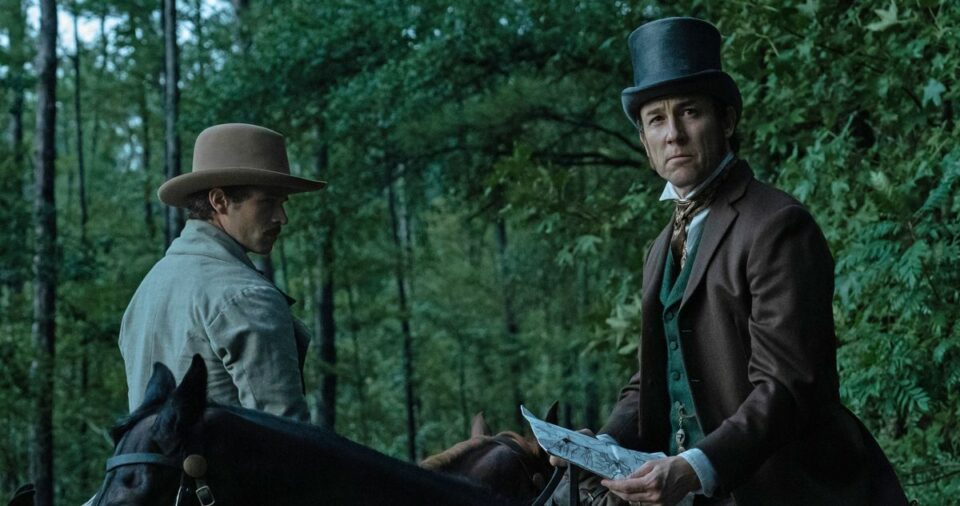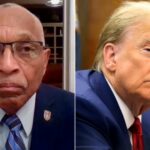
“Secretary, did you order an assassination of President Davis?,” Conover asks Stanton point blank as Baker looks on in the first scene of “The Secret Line.” It’s a question that will hang over the entire episode both in its particulars — did Stanton place the order? — and in its implications. How far would Stanton and, by extension, Lincoln go to win the war? And what is the moral difference, if any, between assassinating the president of the Confederacy and assassinating the president of the United States? There’s another question, too: If Stanton did place the order, why shouldn’t he suspect the remains of the Confederacy would do the same using Booth as their assassin?
Stanton denies ordering Davis’ assassination, more or less, telling Conover that the Dahlgren order is “Confederate propaganda.” And, for a fee, Conover’s willing to tell his readers exactly that. He’s referring to orders found on the body of Col. Ulric Dahlgren after a failed attack on Richmond in 1864 that revealed his mission was not only to free Union soldiers but to burn Richmond to the ground and kill Davis and his cabinet. Whether or not it was a forgery remains an open question, historically speaking, though a later flashback will pretty much confirm that, in the universe of Manhunt at least, Stanton was behind it, having previously argued to Lincoln that the Rules of Engagement don’t apply because Davis is not a legitimate head of state. But true or not, its resurfacing provides Stanton with a reminder of the importance of controlling the narrative. And the narrative he wants to win out is the one tying the Confederacy to Booth’s actions via the snide George Sanders. “No holes,” he tells Baker.
If it were true this would hardly be the only action to break the rules of engagement. A flashback finds Sanders speaking to the Confederate Army of Manhattan, a grandiloquently named group of Confederate sympathizers who attempted to destroy Manhattan by setting a series of fires across the city — mostly at hotels but also at P.T. Barnum’s “museum” — in the hopes of overwhelming the city’s fire department. This did not go well, and tying Sanders to it seems to be a dramatic invention, but it provides another example of just how blurry the battle lines could be and that actions in Manhattan and Montreal could be just as meaningful as direct conflicts.
At the wake for the president, Mary takes comfort from a surprising source: Edwin Booth, John Wilkes Booth’s more famous brother. Or, maybe it’s not so surprising. Like Edwin, Mary has Southern sympathizers in her family and she understands his concern to be real. Others are also concerned about her, but in different ways. Robert fears for his mother’s well being and is looking into mental institutions. This squares with history, but Manhunt’s intriguing choices include the decision to portray Mary not as a screaming madwoman. A flashback to an argument with Abe about Robert’s intent to enlist in the army is perfectly understandable, particularly when she points out the hypocrisy of having a fighting force heavy on Irish and Black men and light on the sons of the wealthy. Perhaps the men in Mary’s life have a different definition of madness than she does.
Over at Dr. Mudd’s place, the other Mary has had enough. Not only does he track mud (appropriately enough) across the floor she just cleaned, he’s well, a huge jerk. Thanks to the land grant she finds the confidence to quit. “Land don’t make everything hunky-dory, girl,” he snarls. And maybe he’s right, but Mary wants to find out for herself. Mary’s new life includes being a teacher as part of a community of newly freed Black citizens who, like her, are looking toward the future with optimism for the first time in their lives.
While Edwin worries about his reputation — and flashes back to his tense, later encounters with John, one set against the backdrop of the Manhattan fires — John and Herold’s journey has reached a standstill. They pass the time bonding over John’s poetry recitation, the previous night’s horse slaughter now apparently forgiven, if not forgotten. Their sojourn ends with the arrival of the River Ghost, who brings them to the next stage of their journey.
Stanton’s current pursuit of Sanders hits snag of its own. Sanders is rich enough to be “untouchable,” a federal judge tells him. “This is America,” Stanton replies. “No one is untouchable.” (And, again, that sound you hear is contemporary resonance.) The judge’s advice: stop the flow of money. That means siccing Baker on Wall Street’s “gold room,” where Confederate sympathizers trade gold against the U.S. dollar for profit. These include Jonathan Lamson (Bill Kelly) who, awkwardly, is also (sort of) Stanton’s father-in-law via Stanton’s late first wife Mary Ann.
Sanders, it would seem, is not happy about this raid and launches one of his own on Baker’s headquarters. Having kept his files locked up, Baker loses nothing, but his own raid seems to have yielded little as well, just some talk about Sanders being at an “oil meeting” in which “oil” may or may not have been code for assassination. But Stanton won’t give up, meeting Larson for lunch and pressing him for information on the deal he suspects Sanders has made with Andrew Johnson. What he offers is unexpected. The rumor is Johnson has given Sanders a contract to make the army’s summer uniforms. Their lunch meeting, which includes Eddie, ends with an awkward toast to Mary, the woman each lost, followed by insults. No one’s getting added to the Christmas list this year.
Except, oops, it’s Stanton who approves the uniform budget, as we learn in a subsequent scene in which Conover, apparently a man with no firm allegiances, tells Sanders he’s made a mistake and that Conover could have gotten him a better deal. With a promise that he’ll continue “doing deals” with Conover in the future, Sanders asks for an in-person meeting with Stanton, a pretty bold request. Does his agreement to meet at Stanton’s office have anything to do with the thugs who beat him up on the street? Probably!
Nonetheless, Stanton shows up at the meeting to talk things over. Specifically, he’s willing to give Sanders the contract if he can give up the location of Booth. Either Sanders can’t or won’t, but either way he seems guilty as hell. Then we get a bookend to the opening scene as Stanton asks, “Look me in the eye and tell me you didn’t have Abe killed.” And, unlike Stanton, he can’t, offering instead that capturing Booth would be futile because Confederate sympathizers are everywhere. He even pulls a gun and brags that he could kill Stanton and not be called a killer. He could kill someone on Wall Street in broad daylight and get away with it (a claim that sounds oddly familiar). But for now he finds himself in a standoff and, when Stanton pulls the trigger, it’s not with the intent to kill but to signal Baker, who then arrests him. This at least seems like a victory.
Elsewhere, Eddie tries to figure out why the Lincoln family’s security detail has disappeared and this, too, seems to have something to do with uniforms, specifically uniforms laden with smallpox. And where did these uniforms come from? “Sanders Clothiers.” Meeting his father there later they interrupt Sanders’ men as they prepare to burn a shipment, while also finding a map of shipments that appears to double as the “secret line,” of the title, the route used to carry supplies and info to Confederate sympathizers. This, too, seems like a victory. But whether either will be what they appear remains to be seen.
Clues and Codes
• We’re past the halfway point with Manhunt now and it continues to alternate between different plot strands and players — Booth and Stanton but also Mary, Baker, Conover, and others — while making connections between each. It’s an impressive bit of storytelling that moves steadily toward a conclusion we know from history but arrives there by an unfamiliar route.
• This route includes some side trips that stray from established historical fact, however. Sanders, for instance, seems to have been a true villain but positioning him as a kind of Moriarty to Stanton’s Holmes involves a lot of creative extrapolation from historical facts.
• The Dahlgren letter, however, only seems like an invention. It’s a truly intriguing bit of history that raises many questions. Manhunt’s narrative, in which Lincoln himself okayed the assassination attempt, is one possible answer. The Weekly accusing Stanton of drafting the orders after the war would have been old news, however. They were published in the Richmond Examiner in March, 1864. This prompted a mob to dig up Dahlgren’s corpse and place it on public display.
• The River Ghost: a man of few words.
By Keith Phipps , 2024-03-29 13:00:00
Source link


